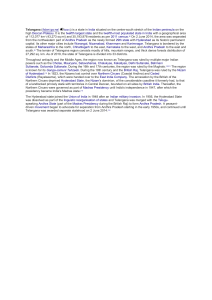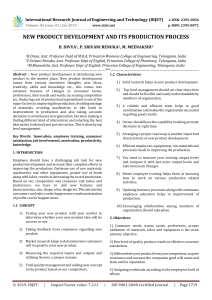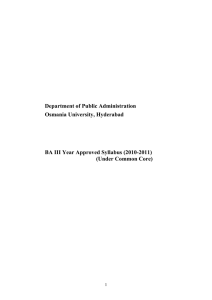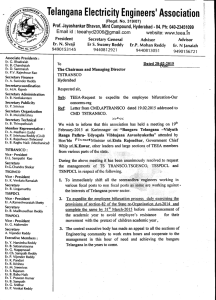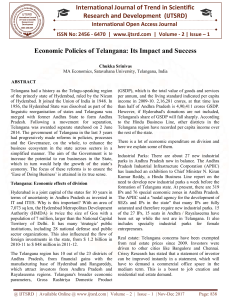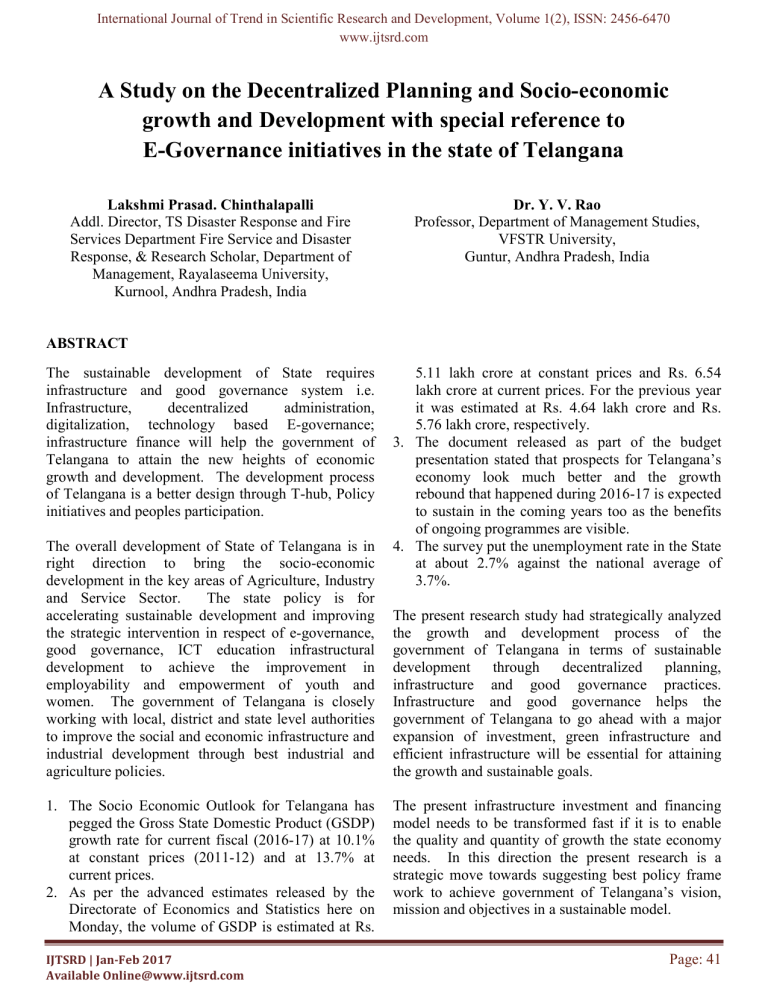
International Journal of Trend in Scientific Research and Development, Volume 1(2), ISSN: 2456-6470
www.ijtsrd.com
A Study on the Decentralized Planning and Socio-economic
growth and Development with special reference to
E-Governance initiatives in the state of Telangana
Lakshmi Prasad. Chinthalapalli
Addl. Director, TS Disaster Response and Fire
Services Department Fire Service and Disaster
Response, & Research Scholar, Department of
Management, Rayalaseema University,
Kurnool, Andhra Pradesh, India
Dr. Y. V. Rao
Professor, Department of Management Studies,
VFSTR University,
Guntur, Andhra Pradesh, India
ABSTRACT
The sustainable development of State requires
infrastructure and good governance system i.e.
Infrastructure,
decentralized
administration,
digitalization, technology based E-governance;
infrastructure finance will help the government of
Telangana to attain the new heights of economic
growth and development. The development process
of Telangana is a better design through T-hub, Policy
initiatives and peoples participation.
The overall development of State of Telangana is in
right direction to bring the socio-economic
development in the key areas of Agriculture, Industry
and Service Sector.
The state policy is for
accelerating sustainable development and improving
the strategic intervention in respect of e-governance,
good governance, ICT education infrastructural
development to achieve the improvement in
employability and empowerment of youth and
women. The government of Telangana is closely
working with local, district and state level authorities
to improve the social and economic infrastructure and
industrial development through best industrial and
agriculture policies.
1. The Socio Economic Outlook for Telangana has
pegged the Gross State Domestic Product (GSDP)
growth rate for current fiscal (2016-17) at 10.1%
at constant prices (2011-12) and at 13.7% at
current prices.
2. As per the advanced estimates released by the
Directorate of Economics and Statistics here on
Monday, the volume of GSDP is estimated at Rs.
IJTSRD | Jan-Feb 2017
Available Online@www.ijtsrd.com
5.11 lakh crore at constant prices and Rs. 6.54
lakh crore at current prices. For the previous year
it was estimated at Rs. 4.64 lakh crore and Rs.
5.76 lakh crore, respectively.
3. The document released as part of the budget
presentation stated that prospects for Telangana’s
economy look much better and the growth
rebound that happened during 2016-17 is expected
to sustain in the coming years too as the benefits
of ongoing programmes are visible.
4. The survey put the unemployment rate in the State
at about 2.7% against the national average of
3.7%.
The present research study had strategically analyzed
the growth and development process of the
government of Telangana in terms of sustainable
development through
decentralized planning,
infrastructure and good governance practices.
Infrastructure and good governance helps the
government of Telangana to go ahead with a major
expansion of investment, green infrastructure and
efficient infrastructure will be essential for attaining
the growth and sustainable goals.
The present infrastructure investment and financing
model needs to be transformed fast if it is to enable
the quality and quantity of growth the state economy
needs. In this direction the present research is a
strategic move towards suggesting best policy frame
work to achieve government of Telangana’s vision,
mission and objectives in a sustainable model.
Page: 41
International Journal of Trend in Scientific Research and Development, Volume 1(2), ISSN: 2456-6470
www.ijtsrd.com
The sustainable rural or urban development of the
state or country is only possible with the right
development of Infrastructure to utilize the resources
and develop the e-governance best practices.
Figure 1.1: Sustainable Infrastructure
The Infrastructure Service in India: The infrastructure
scenario in India being the seventh-largest country in
the world has maintained an infrastructure
management that has enabled India to reach new
heights Developing Infrastructure includes economic
(energy, power, telecom, transport, InfoTech, finance,
etc) and social (education and health issues)
infrastructure development.
Methodology:
Objectives:
The overall country need double-digit growth in
manufacturing and services sectors in the next five
years, and have to double farm output, if it was to
meet the target achievements. The economy has
grown at an average eight per cent in the past three
years, and a 10 per cent annual GDP growth is
difficult to achieve unless the country improves its
infrastructure.
Infrastructure growth and development through
decentralized planning is required in the following
sectors
1. Transport & Communication Infrastructure
2. Power Infrastructure
3. Financial Infrastructure
4. Social Infrastructure
5. Education Infrastructure
6. Health Infrastructure
1. To study the decentralised planning, infrastructure
and good governance developments in India in
general and Telangana in particular
2. To analyze the socio economic through
decentralised planning in the State of Telangana
3. To study the government initiatives and policy
measures towards development of infrastructure in
India and Telangana
4. To analyze the contribution of e-Governance and
smart city concept in the development process of
Telangana
5. To suggest efficient and effective measures to
develop infrastructure and best practices in the
state of Telangana
IJTSRD | Jan-Feb 2017
Available Online@www.ijtsrd.com
The study was conducted with collecting primary and
secondary data. Cluster sampling technique adopted
by taking Rangareddy and Warangal districts in the
state of Telangana. 500 sample respondents have been
taken from the sample districts to obtain socioeconomic developments through decentralized
planning and e-governance implementation.
Page: 42
International Journal of Trend in Scientific Research and Development, Volume 1(2), ISSN: 2456-6470
www.ijtsrd.com
The Development of infrastructure and decentralized
planning is one of the priorities for development of
Indian economy towards social development. Good
governance is required to a great extent to contribute
soco-economic development through development of
infrastructure in the areas of Agriculture, and Social
& Rural Infrastructure. The development of ICT and
web based technology towards good governance
practices to improve the decentralized planning
system to develop smart cities and industrial
development will contribute to the welfare of
mankind.
Figure 1.2: ICT Infrastructure
The present Government is facing various challenges
such as best Governance, faster land, environmental
and other policies, availability of long term funds,
timely implementation of projects within estimated
costs, and at the same time protecting interest of all
stakeholders.
More number of Urban Infrastructure experts needed
annually as said by the Expert Committee for
estimating the investment requirements for Urban
Infrastructure Roads, Power, Aviation, Seaports,
Urban Infrastructure, Railways, Agriculture; Social &
Rural Infrastructure is struggling to keep pace with
the expected results.
The development of Telangana state requires huge
funds and technocrats with formal professional
education for creating comprehensive & multifaceted
capabilities to improve the good governance system to
improve the economic development and rural
transformation process of Hyderabad capital into a
world class capital by developing good infrastructure
related to Roads, Power, Aviation, Urban
Infrastructure, Railways, Agriculture, and Social &
Rural Infrastructure. Infrastructure was exclusively
used to describe public assets that facilitate
production, but not private assets of the same purpose
which plays an important role in the development of
an economy.
Figure 1.3: Sustainable Economic development
India is the fourth largest economy in the world. The
development of infrastructure requires a further
development in respect of Physical and social
infrastructure which has a direct impact on the growth
IJTSRD | Jan-Feb 2017
Available Online@www.ijtsrd.com
and overall development of an economy. The fast
growth of the Indian economy in recent years has
placed increasing stress on physical infrastructure,
like electricity, railways, roads, ports, airports,
irrigation, urban as well as rural water supply and
sanitation.
Page: 43
International Journal of Trend in Scientific Research and Development, Volume 1(2), ISSN: 2456-6470
www.ijtsrd.com
Infrastructure and decentralized planning for an
economy:
Infrastructure and decentralized planning helps in the
efficient utilization of country resources in respect of
agriculture with the help of irrigation facilities, raw
materials and industrial capacity of the country with
the help of transport, communication, power facilities,
and country’s labour force with the help of education,
training and health facilities.
The development of the country largely depends on
sound infrastructural facilities in respect of agriculture
sector or the industrial sector. Without Infrastructure
the output cannot be enhanced. If there is sufficient
arrangement of irrigation in time it will boost up the
agriculture production. Similarly industrial output also
gets momentum with the help of power, transport and
technical facilities. Infrastructure and decentralized
planning of Economy For the sake of convenience we
generally classify the infrastructures of an economy in
two groups :-
1. Extension of market goes along with development
of transport and communication facilities. If the
monetary and financial institutions are properly
developed in the country, the various sectors of
economy can get finance easily and adequately
2. This increases the efficiency of labour by giving
education training and health facilities, transport
facilities which make it possible for the workers to
go to long and distant places for work and this
increases their mobility.
Infrastructure indicates that facilities and services
which facilitate different economic activities and
thereby help in economic development of the country
in the areas Education, Health, Transport and,
irrigation and power, Communication, banking and
insurance and science and technology. Social
overhead capital, produce, goods and services induce
production in agriculture, industry and trade by
generating external economies. For instance, an
industry situated on or near the railway line or
national highway will produce commodities at less
cost.
Infrastructure: Socio economic development
Infrastructure is the basic requirement of economic
development. It directly produce goods and services
and facilitates production in primary, secondary and
tertiary economic activities by creating positive
external economies. The level of economic
development in any country directly depends on the
development of infrastructure. The developed
countries have made a tremendous growth of social
and economic infrastructure and revolutionary
progress in transport and communication sectors.
IJTSRD | Jan-Feb 2017
Available Online@www.ijtsrd.com
The infrastructure can be divided into two categories:
hard Infrastructure, soft Infrastructure.
Among the components that are classified under the
infrastructure are the capital assets such as the public
utilities, transport
vehicles, telecommunication
systems, roads, highways, railways, subways, traffic
lights and street lights, dams, walls and culverts,
drainage systems, the airports and bus terminals, and
bridges, among others.
In respect of private infrastructure the land, the
buildings and other improvements, the electric posts
Page: 44
International Journal of Trend in Scientific Research and Development, Volume 1(2), ISSN: 2456-6470
www.ijtsrd.com
and the water systems, the warehouses and storage
facilities, and the vehicles. Infrastructure is further
classified into transportation, energy, communication,
water management, measurement networks, and waste
management.
REFERENCES:
1. Singh, S. P. (2000) „Gram Panchayats: Assessing
Developmental Goals, Motivational Factors and
Orientation: Evidence from a Field Study‟,
Journal of Rural Development, 19 (3), pp. 371-97.
2. Smith,B.C.(1985)
Decentralization:
The
Territorial Dimension of the State, London:
George Allen & Unwin.Stiglitz, J. (1994) Whither
Socialism? MIT Press.
3. Tanzi,
V. (1996) Fiscal Federalism and
Decentralization: A Review ofSome Efficiency
and Macroeconomic Aspects, Annual Bank
Conference on Development Economics, The
World Bank, Washington D.C., pp. 295-316.
4. Tharakan, P. K. M (1998) „Socio-religious reform
movements, process of democratization and
human development: The case of Kerala, SouthWest India‟, in: Rudebek, L., Törnquist, O. and
Rojas, V. (eds) Democratisation in the Third
World: Concrete cases in comparative and
theoretical perspective, London: Macmillan and
St. Martin‟s Press.
IJTSRD | Jan-Feb 2017
Available Online@www.ijtsrd.com
Page: 45

